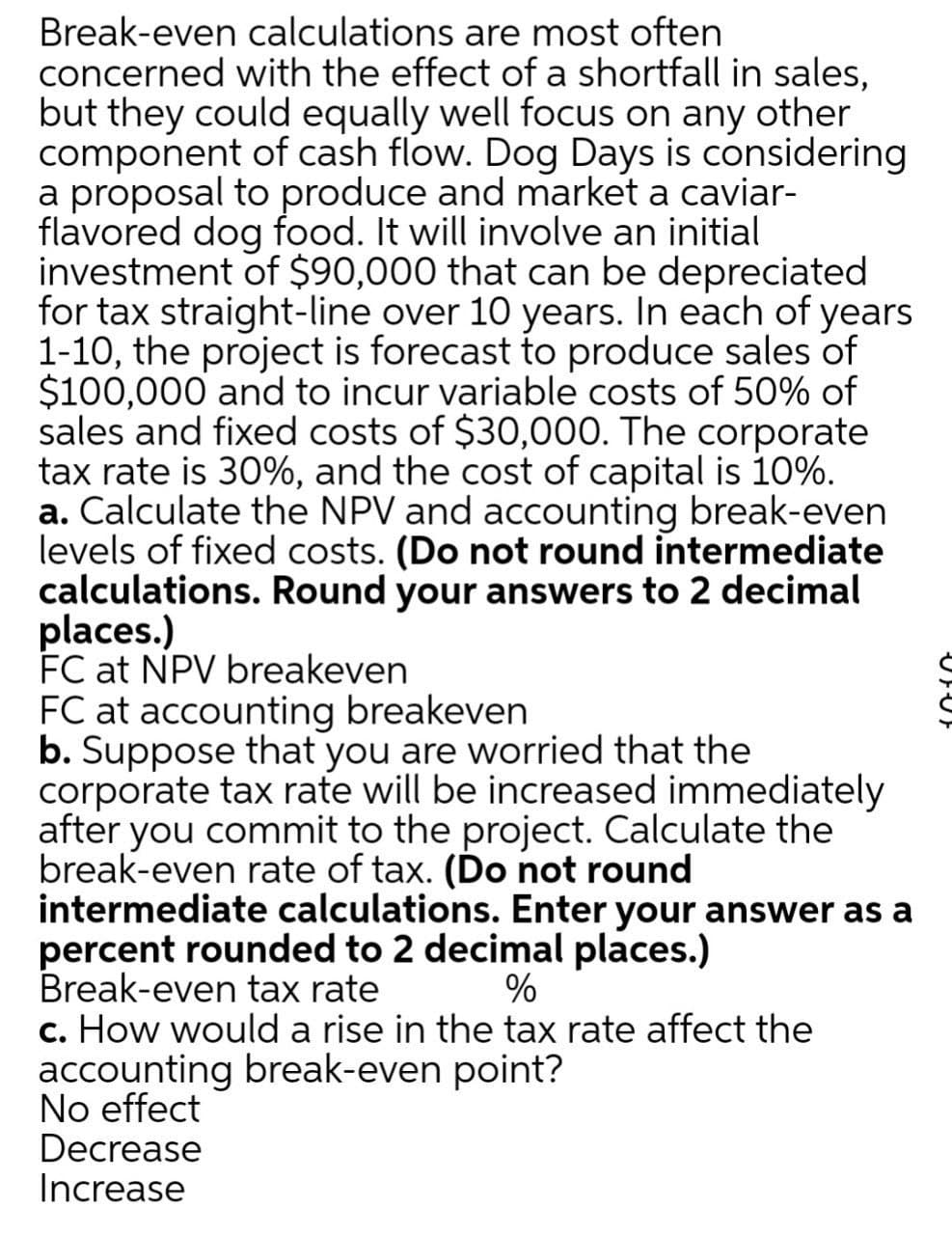NPV
Cornerstones of Cost Management (Cornerstones Series)
4th Edition
ISBN:9781305970663
Author:Don R. Hansen, Maryanne M. Mowen
Publisher:Don R. Hansen, Maryanne M. Mowen
Chapter19: Capital Investment
Section: Chapter Questions
Problem 9E: Each of the following scenarios is independent. All cash flows are after-tax cash flows. Required:...
Related questions
Question
Urgent it is

Transcribed Image Text:Break-even calculations are most often
concerned with the effect of a shortfall in sales,
but they could equally well focus on any other
component of cash flow. Dog Days is considering
a proposal to produce and market a caviar-
flavored dog food. It will involve an initial
investment of $90,000 that can be depreciated
for tax straight-line over 10 years. In each of years
1-10, the project is forecast to produce sales of
$100,000 and to incur variable costs of 50% of
sales and fixed costs of $30,000. The corporate
tax rate is 30%, and the cost of capital is 10%.
a. Calculate the NPV and accounting break-even
levels of fixed costs. (Do not round intermediate
calculations. Round your answers to 2 decimal
places.)
FC at NPV breakeven
FC at accounting breakeven
b. Suppose that you are worried that the
corporate tax rate will be increased immediately
after you commit to the project. Calculate the
break-even rate of tax. (Do not round
intermediate calculations. Enter your answer as a
percent rounded to 2 decimal places.)
Break-even tax rate
c. How would a rise in the tax rate affect the
accounting break-even point?
No effect
Decrease
Increase
Expert Solution
This question has been solved!
Explore an expertly crafted, step-by-step solution for a thorough understanding of key concepts.
Step by step
Solved in 3 steps with 3 images

Knowledge Booster
Learn more about
Need a deep-dive on the concept behind this application? Look no further. Learn more about this topic, accounting and related others by exploring similar questions and additional content below.Recommended textbooks for you

Cornerstones of Cost Management (Cornerstones Ser…
Accounting
ISBN:
9781305970663
Author:
Don R. Hansen, Maryanne M. Mowen
Publisher:
Cengage Learning

Intermediate Financial Management (MindTap Course…
Finance
ISBN:
9781337395083
Author:
Eugene F. Brigham, Phillip R. Daves
Publisher:
Cengage Learning

EBK CONTEMPORARY FINANCIAL MANAGEMENT
Finance
ISBN:
9781337514835
Author:
MOYER
Publisher:
CENGAGE LEARNING - CONSIGNMENT

Cornerstones of Cost Management (Cornerstones Ser…
Accounting
ISBN:
9781305970663
Author:
Don R. Hansen, Maryanne M. Mowen
Publisher:
Cengage Learning

Intermediate Financial Management (MindTap Course…
Finance
ISBN:
9781337395083
Author:
Eugene F. Brigham, Phillip R. Daves
Publisher:
Cengage Learning

EBK CONTEMPORARY FINANCIAL MANAGEMENT
Finance
ISBN:
9781337514835
Author:
MOYER
Publisher:
CENGAGE LEARNING - CONSIGNMENT



Principles of Accounting Volume 2
Accounting
ISBN:
9781947172609
Author:
OpenStax
Publisher:
OpenStax College